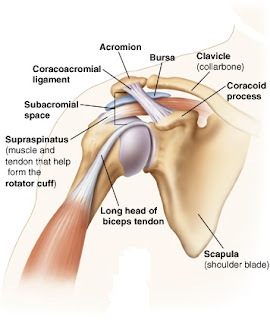THE ROTATOR CUFF – the stabilizer
Shoulder, is one of the most dynamic
part of our body. Serving us with a lot of functions in our day-to-day life.
Shoulder joint connects the arm with the axial body. The shoulder joint is an anatomical
structure of our body, providing the human skeleton immense power to carry out
lots and lots of functions, not only dynamically but statically as well. The
muscles surrounding the shoulder joint not only functions while carrying out
some action but also works at rest. There are many different structures that contributes
in the formation and function of the shoulder joint. We are discussing about
one of the most powerful muscles that helps the shoulder joint to play its
part- “THE ROTATOR CUFF”. This muscle is like a team of four different muscles
along with their tendon named as, SUPRASPINATUS, INFRASPINATUS, TERES MINOR AND
SUBSCLAPULARIS, which play their individual parts in performing different
movements at shoulder joint and also helps in the stabilization of the joint.
Before we start with the role of the
rotator cuff as a whole let’s have a look on the location and the position of
the muscles involved in the rotator cuff.
· The SUPRASPINATUS, the muscle above
the shoulder, lies in scapular plane (the upper border of the shoulder), is the
location of one of the most important muscles, (origination from the
supraspinous fossa and inserting in the superior facet of the greater
tubercle),
· The INFRASPINATUS (originated form the
infraspinous fossa and inserting in the posterior facet of the greater
tubercle),
· The TERES MINOR (originating from the middle
half of the lateral border of the scapula and inserting in the inferior facet
of the greater tubercle),
· The SUBSCAPULARIS (originating from the
subscapular fossa and inserting in the lesser tubercle).
As the shoulder joint is the ball and socket joint, the rotator cuff
muscle holds the ball called as the head of the humerus in the socket called as
the glenoid cavity.
The 'rotator cuff' as the name suggests, rotates the shoulder joint
(internal and external rotation) and enables the movement of abduction at the
shoulder joint. The subscapularis and infraspinatus enables the movement of
scaption i.e. the scapular plane shoulder abduction. The supraspinatus muscles
play an important role in initiation of the movement of abduction at shoulder
joint and provides 53% of the total strength to the cuff. The infraspinatus
externally rotates the humerus and acts primarily when the arm is in neutral,
the subscapularis internally rotates the humerus and the teres minor externally
rotates the humerus and is more active in 90 degrees of abduction
The muscle most vulnerable to the injury is the supraspinatus muscle, the
primary reason perhaps is the location of the muscle. The repetitive stress
injury causes major damage to the supraspinatus muscle. Example can be given of
someone carrying a bag on the shoulder. Rotator cuff muscle can also get
injured by performing repeated overhead activities. The major damage caused to
the rotator cuff can result in
· Rotator cuff tear
· Rotator cuff impingement
· Rotator cuff tendinitis
If you are having any of the above conditions you may experience the
following symptoms
ü Pain in and around the shoulder
ü Stiffness around the shoulder
ü Weakness of the muscles
ü Inability to perform movements of
abduction (lifting the arm by the side) and external rotation (taking the arm
outwards)
ü Arm feels heavy
ü Arm feels hanging
ü Soreness after exercise







Comments